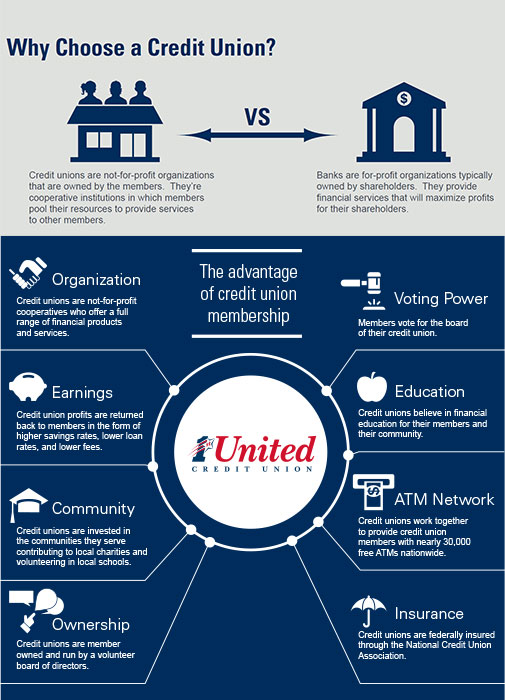Hybrid Line of Credit: Innovative Financial Products from Wyoming Credit Unions
Hybrid Line of Credit: Innovative Financial Products from Wyoming Credit Unions
Blog Article
The Ultimate Guide to Comprehending Cooperative Credit Union

Cooperative credit union stand as one-of-a-kind monetary entities, rooted in concepts of common support and member-driven operations. However, beyond their foundational values, recognizing the complex workings of lending institution involves a deeper exploration. Deciphering the complexities of subscription eligibility, the advancement of solutions used, and the distinctive benefits they bring requires a comprehensive assessment. As we navigate via the ins and outs of cooperative credit union, an informative trip awaits to shed light on these member-focused establishments and how they vary from traditional financial institutions.
What Are Lending Institution?
Cooperative credit union are member-owned financial organizations that provide a series of financial services to their members. Unlike typical banks, cooperative credit union run as not-for-profit companies, suggesting their key emphasis gets on offering their participants as opposed to maximizing profits. Participants of a cooperative credit union commonly share an usual bond, such as working for the exact same employer, belonging to the same area, or being component of the exact same company.
Among the essential advantages of cooperative credit union is that they usually offer greater passion prices on cost savings accounts and lower rates of interest on lendings compared to financial institutions. Credit Unions in Wyoming. This is because credit history unions are structured to benefit their members straight, allowing them to hand down their incomes in the kind of better rates and fewer costs. Additionally, cooperative credit union are known for their personalized customer care, as they focus on building connections with their participants to comprehend their distinct financial demands and goals
Background and Development of Credit Scores Unions
The origins of member-owned financial cooperatives, recognized today as lending institution, trace back to a time when communities looked for alternatives to standard financial organizations. The principle of credit rating unions stem in the 19th century in Europe, with Friedrich Wilhelm Raiffeisen typically credited as the pioneer of the participating financial movement. Raiffeisen established the first acknowledged credit history union in Germany in the mid-1800s, stressing area support and self-help concepts.
The development of lending institution continued in North America, where Alphonse Desjardins established the initial lending institution in Canada in 1900. Quickly after, in 1909, the very first U.S. cooperative credit union was formed in New Hampshire by a team of Franco-American immigrants. These very early cooperative credit union operated on the basic concepts of mutual aid, autonomous control, and member ownership.
Over time, lending institution have expanded in popularity worldwide because of their not-for-profit framework, concentrate on serving participants, and using competitive economic services and products. Today, lending institution play an important role in the economic market, supplying accessible and community-oriented financial choices for services and people alike.

Membership and Qualification Criteria
Membership at a credit score union is usually restricted to people satisfying certain eligibility requirements based on the institution's starting principles and governing needs. Some credit score unions might just offer individuals who work or live in a particular location, while others might be tailored to staff members of a certain business or participants of a specific organization.
Furthermore, lending institution are structured as not-for-profit organizations, implying that their main objective is to serve their participants as opposed to produce earnings for shareholders. This concentrate on participant solution frequently converts right into more individualized attention, lower costs, and competitive rates of interest on financial savings and finances accounts. By meeting the qualification requirements and becoming a participant of a lending institution, people can access a variety of financial services and products customized to their certain needs.
Services and Products Supplied
One of the key elements that sets lending institution apart description is the diverse series of economic product and services they offer to their members. Cooperative credit union usually supply conventional banking services such as cost savings and inspecting accounts, car loans, and charge card. Members can likewise benefit from investment services, consisting of retired life accounts and monetary preparation assistance. Several lending institution offer affordable rates of interest on interest-bearing accounts and car loans, as well as reduced costs compared to typical banks.
Furthermore, lending institution commonly offer practical online and mobile banking options for members to easily manage their finances. They may supply advantages such as shared branching, permitting participants to access their accounts at various other lending institution throughout the country. Some debt unions also offer insurance products like auto, home, and life insurance coverage to assist members protect their properties and loved ones.

Benefits of Banking With Cooperative Credit Union
When considering economic institutions, checking out the advantages of banking with credit rating unions reveals unique benefits for members seeking tailored service and affordable rates. Unlike huge banks, credit history unions are member-owned and prioritize building strong connections with their members. Generally, financial with a credit scores union can supply a much more personalized, affordable, and member-centric economic experience.
Final Thought
In conclusion, credit rating unions stand out as member-owned banks that prioritize offering their participants over taking full advantage of revenues. With origins dating back to 19th century Europe, credit score unions adhere to principles of common support and participant ownership. They use a variety of economic product and services, consisting of standard resource financial services, financial investment choices, and competitive passion prices. Subscription eligibility standards are certain and mirror a community-oriented approach, providing tailored customer support and a member-centric financial experience.
Credit scores unions are member-owned monetary establishments that supply a range of financial services to their members. The idea of credit unions come from in the 19th century in Europe, with Friedrich Wilhelm Raiffeisen often attributed as the pioneer of the participating banking motion.The advancement of credit history unions continued in North America, where Alphonse Desjardins established the initial why not try this out credit report union in Canada in 1900. Credit unions commonly give conventional banking services such as cost savings and checking accounts, loans, and credit score cards.When considering economic institutions, exploring the advantages of financial with credit score unions exposes one-of-a-kind advantages for members looking for customized service and competitive prices.
Report this page